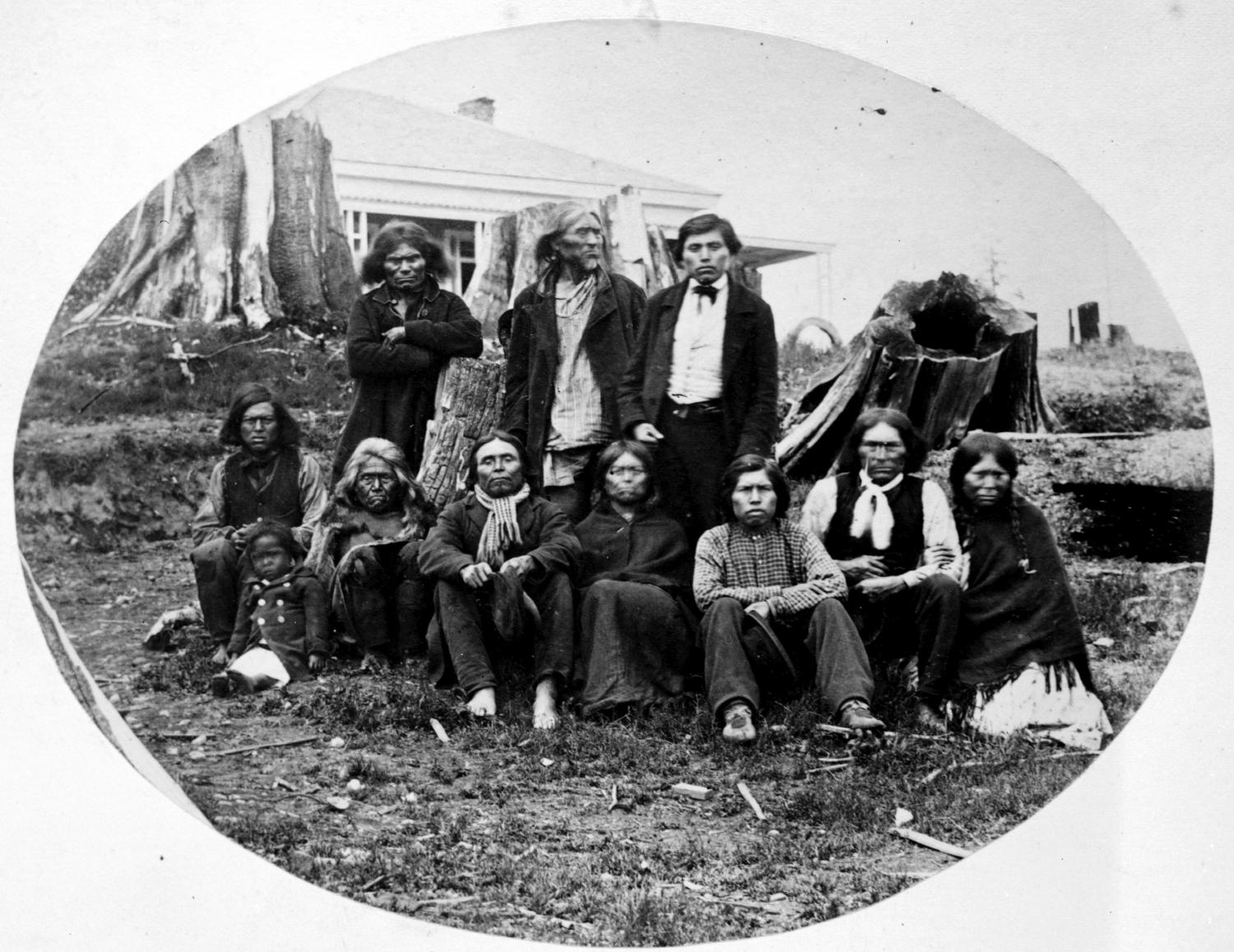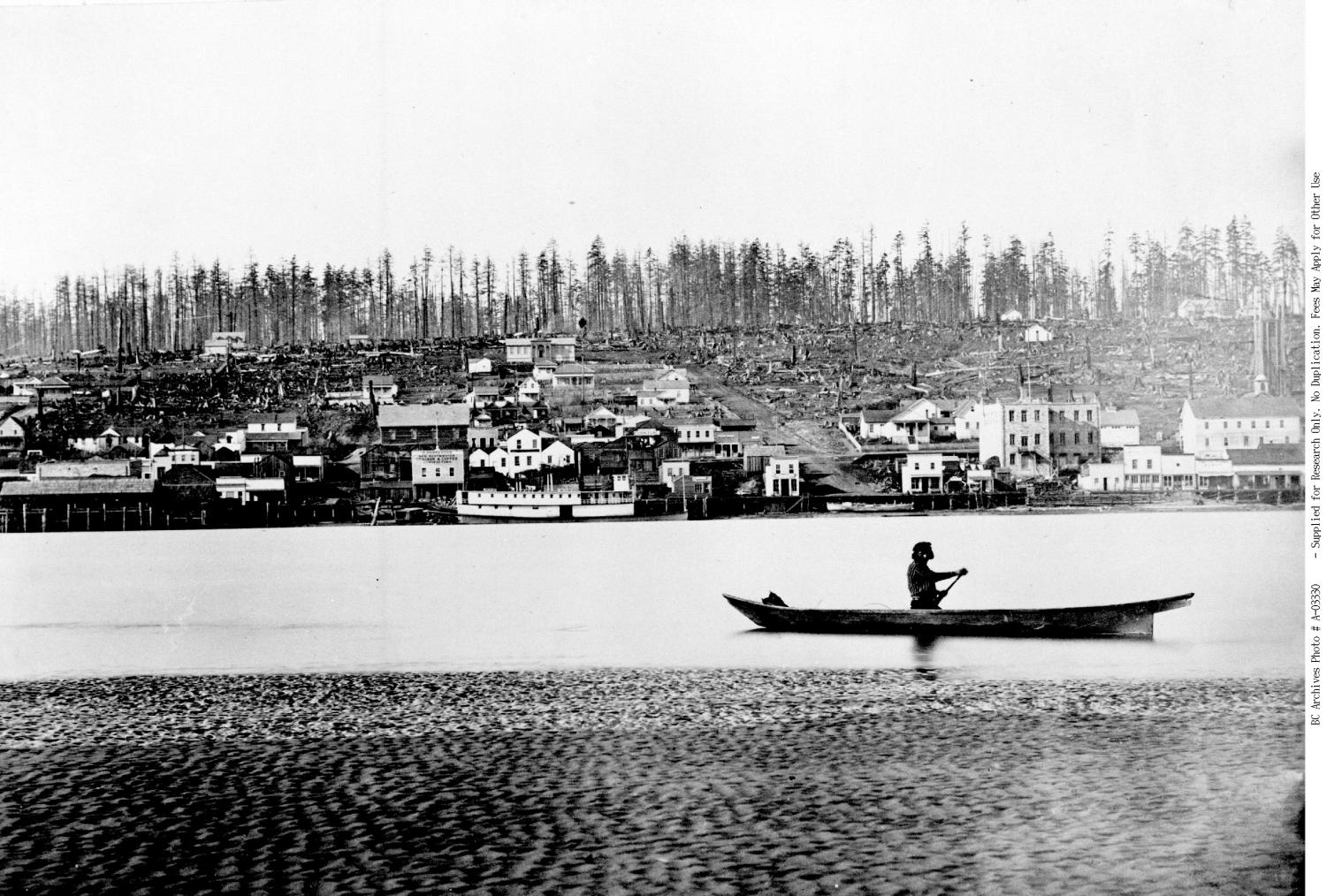Mainland B.C. Becomes Colony
Spurred on by a gold rush, New Caledonia becomes the Colony of British Columbia
Date: 1858
By 1858, the word was out: gold had been found on the Fraser River. That spring, thousands of miners began rushing north from California on their hurried way to British Columbia’s goldfields. It was this monumental event, the Fraser Canyon Gold Rush, that led to the Colony of British Columbia’s creation and, ultimately, B.C’s decision to join Canada 13 years later. For that reason, renowned historian Jean Barman calls 1858 “the single most important year in British Columbia’s history.”
In the decades leading up to 1858, Britain had entrusted the Hudson’s Bay Company (HBC) to oversee much of what is now known as B.C. The territory once comprised the northern half of HBC’s Columbia District, which stretched into Washington, Oregon, Idaho and parts of Montana and Wyoming. Before becoming an official colony, many referred to B.C. as New Caledonia. Beyond a scattering of trading posts, there was little for the HBC to administer. Indigenous people still made up the vast majority of the population. But with the discovery of gold on the Fraser River, James Douglas, governor of colonial Vancouver Island and the HBC’s chief executive in the region, knew change was afoot.
Anticipating the frenzy to come, Douglas attempted to reinforce the Empire’s authority on the mainland by unilaterally declaring British sovereignty. In December 1857, months before the gold rush kicked off, he introduced a measure requiring miners to buy licences before heading off to prospect. A British gunboat was stationed at the mouth of the Fraser to enforce the new rule. Given his limited authority and resources, there was little else he could do to maintain order. By summer’s end, as many as 25,000 men, mostly American, had poured into the region, propelled by what newspapers had dubbed “Frazer River fever.”
With so many armed Americans roaming the mainland, Douglas worried the United States might try to annex the territory. In May, he wrote to British Prime Minister Edward Stanley: “I am now convinced that it is utterly impossible, through any means within our power, to close the gold districts against the entrance of foreigners, as long as gold is found in abundance, in which case the country will soon be overrun.” Clashes between miners and local Indigenous peoples began almost as soon as the newcomers had shown up. Embracing the vigilantism that had prospered in the American West, miners burned villages, lynched Indigenous leaders and committed other violence, which often invited retaliation by Indigenous warriors. In a June letter to London, Douglas stressed the potential for a “disastrous Indian war.” In the end, the bloody war Douglas had feared was all but narrowly avoided thanks to a peace brokered by Cexpe’nthlEm, Grand Chief Spintlum of Lytton.
On Aug. 2, 1858, Britain answered Douglas’s call and added much of the mainland to its long list of Crown colonies. New Caledonia would now be known as ‘British Columbia,’ a name Queen Victoria reportedly chose herself. Later that month, Douglas became B.C.’s first governor after agreeing to relinquish his role as the HBC’s chief factor. He continued, however, to serve as governor of neighbouring Vancouver Island, where he resided. Britain had established a legislative assembly with nominal powers on the island in 1856. But it gave Douglas absolute power to run the mainland as he saw fit instead of — in the words of Secretary of State for the Colonies Edward Bulwer Lytton — “risk[ing] at once the experiment of self-government among settlers so wild, so miscellaneous, and perhaps so transitory.”
Douglas expected Fort Langley, a bustling HBC trading post on the banks of the lower Fraser River, to be British Columbia’s capital. But for military reasons, Colonel Richard Clement Moody ultimately chose a steep, heavily treed site further west along the river. New Westminster, another name chosen by the Queen, stands where the Kwantlen people’s main village, Skaiametl, once was. The sudden rush of newcomers displaced the Kwantlen, permanently disrupting their way of life and connection to the land. Indigenous communities across the mainland experienced the same fate. The fur trade era was over. In its path was a new, larger class of settlers less interested in economic exchange with Indigenous people and more set on ‘civilizing’ the frontier and those who had long lived there.
Sources:
1. Barman, Jean. The Fraser River Gold Rush and the Founding of British Columbia. The Canadian Encyclopedia, 1 Aug. 2013, thecanadianencyclopedia.ca/en/article/gold-rush-sparked-american-interest-in-bc-feature.
2. Bulwer-Lytton, Edward. “Speeches of Edward Lord Lytton Now First Collected, with Some of His Political Waitings Hitherto Unpublished and a Preparatory Memoir by His Son.” Internet Archive, W. Blackwood, 1874, archive.org/details/speechesedwardl00unkngoog.
3. First Peoples of the Northwest Coast: Home Activity Resource Kit (GRADES 4 – 8). New Westminster Museums and Heritage Services, www.newwestcity.ca/database/files/library/NWMA_2020_First_Peoples_of_the_Northwest_Coast_Online_Kit(1).pdf.
4. Fisher, Robin. Contact and Conflict Indian -European Relations in British Columbia,1774-1890. UBC Press, 2014.
5. History: Discover Your Legislature Series. Legislative Assembly of British Columbia, www.leg.bc.ca/content/legacy/Web/37th5th/_media/flash/History.pdf.
6. Hunter, Justine. 1858: How a Violent Year Created a Province. The Globe and Mail, 18 Nov. 2008, www.theglobeandmail.com/news/national/1858-how-a-violent-year-created-a-province/article663220/.
7. Marshall, Daniel P., et al. Fraser River Gold Rush. The Canadian Encyclopedia, 27 Nov. 2006, www.thecanadianencyclopedia.ca/en/article/fraser-river-gold-rush.
8. Marshall, Daniel Patrick. Claiming the Land : Indians, Goldseekers, and the Rush to British Columbia. University of British Columbia Open Collections, 13 Feb. 2000, open.library.ubc.ca/cIRcle/collections/ubctheses/831/items/1.0089642.
9. Marshall, Daniel. War in the New El Dorado and the Birth of British Columbia: Part 1. The Orca, 12 Oct. 2019, theorca.ca/resident-pod/war-in-the-new-el-dorado-and-the-birth-of-british-columbia-part-one/.
10. Ormsby, Margaret A. DOUGLAS, Sir James. Dictionary of Canadian Biography, www.biographi.ca/en/bio.php?andid_nbr=4955andinterval&id_nbr=4955.
11. Ormsby, Margaret A. Sir James Douglas. The Canadian Encyclopedia, 14 Feb. 2008, www.thecanadianencyclopedia.ca/en/article/sir-james-douglas.
12. Roy, Patricia, and John Herd Thompson. British Columbia: Land of Promises. Langara College, 2006.
13. Wright, Eric. Fraser Canyon War. The Canadian Encyclopedia, 10 Apr. 2019, www.thecanadianencyclopedia.ca/en/article/fraser-canyon-war.





